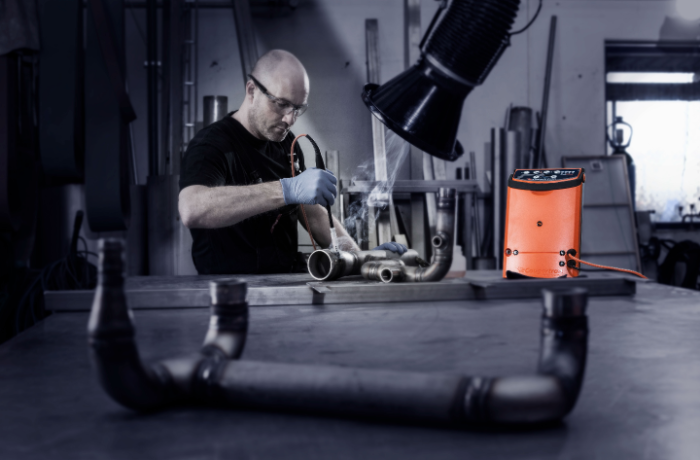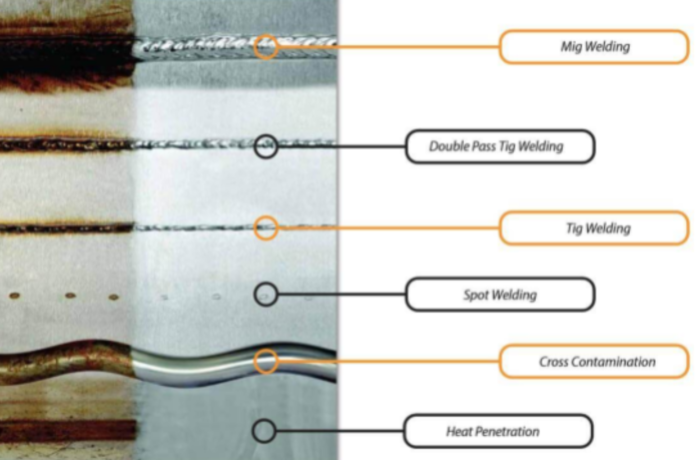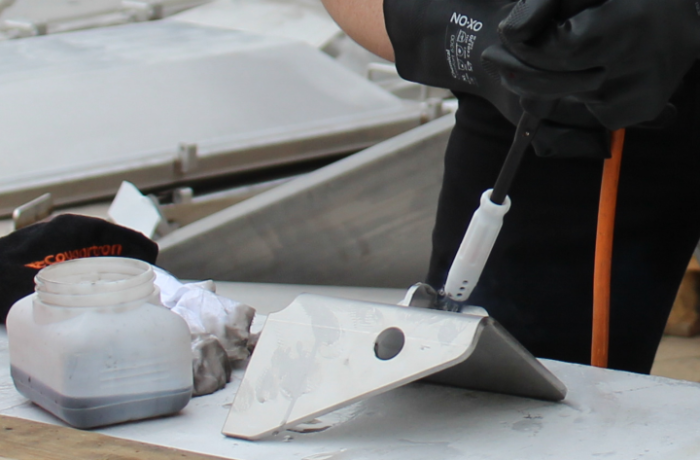Top 5 weld cleaning and passivation methods for stainless steel
Weld cleaning | Stainless steel | Wednesday, 18 May 2022
Not quite sure which weld cleaning and passivation method to use?
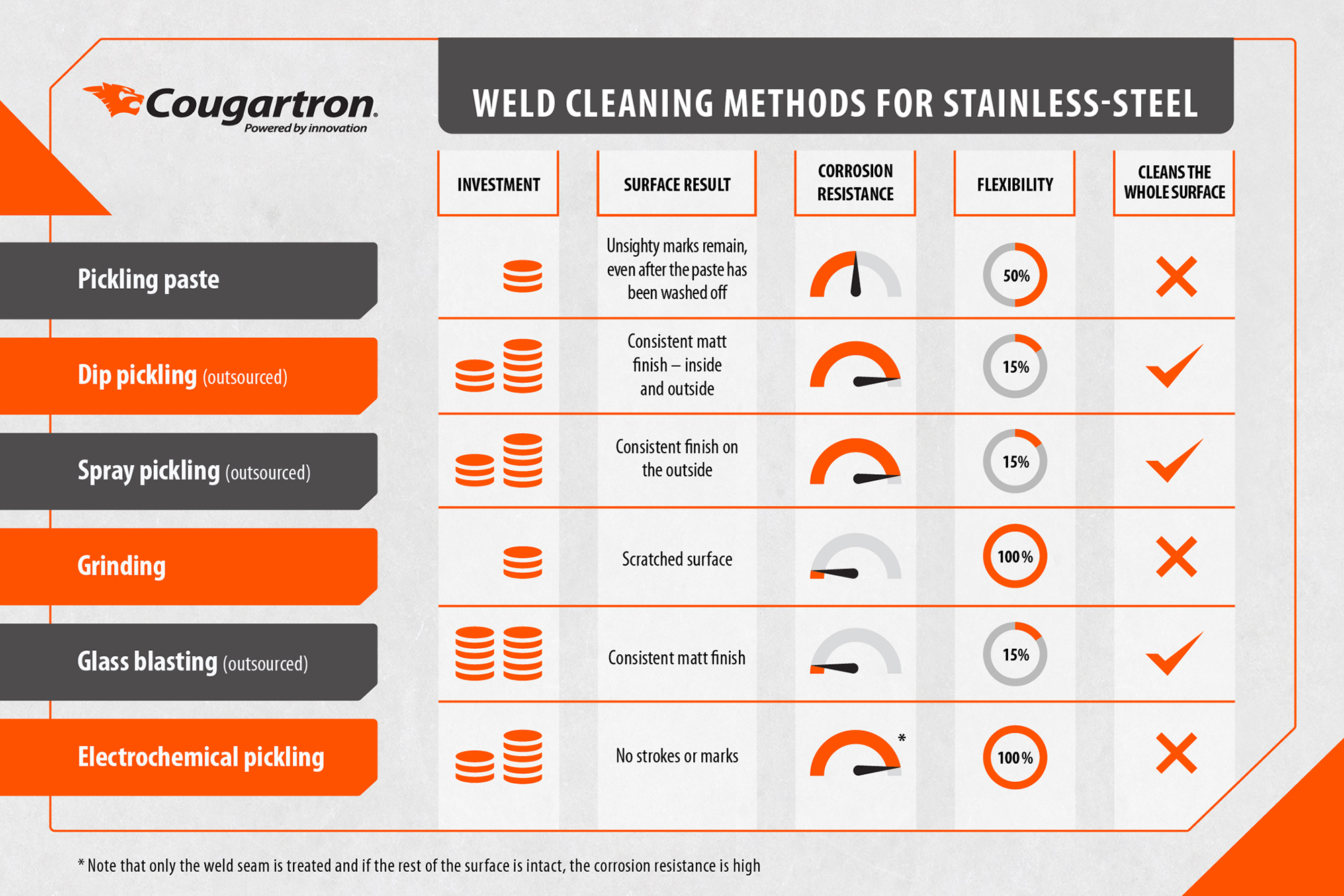
There are multiple methods for cleaning and re-passivating stainless steel welds.
Depending on the size, structure, and type of your weld – as well as multiple other production-related factors – you will notice that each method has its advantages and disadvantages.
Here at Cougartron, we love to share our knowledge about weld cleaning, and help you choose the right solution for your stainless steel welds – even if it’s not ours.
When you are done reading this article, you will hopefully be in a position to choose a weld cleaning solution that best suits your requirements.
Pickling paste
Pros:
- Low cost
Cons:
- Extremely dangerous for you and the environment
- Requires a permit
- Wastewater from rinsing must be collected
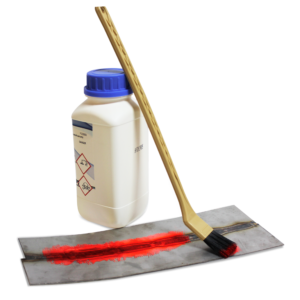
Chemical pickling is a widely used and cheap way of removing oxides from welds.
Due to the dangerous chemicals they contain (sulfuric acid, hydrofluoric acid, and nitric acid), pickling and passivation pastes most often require a permit to buy.
READ MORE ABOUT THE DANGERS OF PICKLING PASTE HERE
Over the years, the harmful effects of pickling paste have faced increased attention from work safety authorities, and legal regulations around the use of pickling paste have gotten even stricter.
Pickling and passivation paste is a viscous liquid (gel) that is applied to the weld seam and is washed of after about 30 to 60 minutes.
However, washing the paste off is a tricky business.
The resulting wastewater is extremely polluting and cannot be just washed down the drain.
Instead, you must collect the water and dispose of it at a local disposal facility. The end-result is a corrosion resistant weld seam.
However, all areas where the paste was once applied retain an unsightly matt appearance. Professionals often polish these areas with products such as scotchbrite discs, which obviously consumes more time.
Although the use of pickling paste is widespread, we predict that modern and safer alternatives such as electrochemical weld cleaning are becoming increasingly important – an outcome that is preferable to both human health and the environment.
Dip and spray pickling
Pros:
- Consistent look on the whole surface
- High corrosion resistance on the whole surface
- Time-efficient with many small items (dip pickling)
Cons:
- When using a subcontractor pickling service: Unwanted lead times and transport cost
- When using an in-house pickling plant: Expensive waste disposal and health and safety risk

Dip pickling and passivation involve dipping the whole piece (hence the name) into a bath with pickling fluid.
The items will get a nice evenly-pickled surface both on their internal and external surface.
Since the items are completely immersed, this method is highly effective with tubes and work pieces with narrow areas and corners, which are difficult to reach manually.
It is expensive to set up your own dip pickling and passivation plant, and therefore it is quite common to pay subcontractors for the job. Disadvantages of this approach are mainly related to transport costs and increased lead times – which greatly contributes to the inefficiency of the work process.
It’s common that dip pickling plants offer spray pickling and passivation as well. Spray pickling is advantageous with very big items, as the pickling fluid is sprayed onto the surface and rinsed off, usually after 30-60 minutes. Due to the environmental laws and safety requirements, spray pickling is performed by professionals that collect and dispose of the acids and wastewater.
Spray pickling is often used if the item is too big for dip pickling and can also be performed with a mobile pickling plant where a professional will spray pickle the item on-site if it is too complicated to move.
Mechanical grinding/polishing
Pros:
- Cheap and relatively fast
Cons:
- Not corrosion resistant
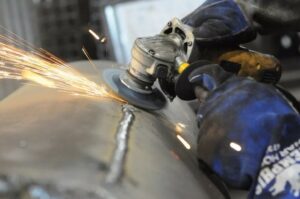
Mechanical grinding is a cheap and relatively fast way of removing oxides from stainless steel welds using power tools such as angle grinders.
However, grinding destroys the passive layer on the steel surface making it less-corrosion resistant – especially outdoors. The layer may or may not reappear days after treatment.
The surface also remains uneven (wavy) after grinding, which impairs the appearance of the steel.
In some instances, a satin polished or brushed surface is required, including the weld seam. However, this process requires specialized polishing equipment and highly trained personnel – and should only be chosen if absolutely necessary.
SEE 5 DISADVANTAGES OF MECHANICAL GRINDING HERE
Glass blasting
Pros:
- No chemicals
Cons:
- Not fully corrosion resistant
- There is a risk of getting metal particles blasted into the surface
- Slow and expensive process
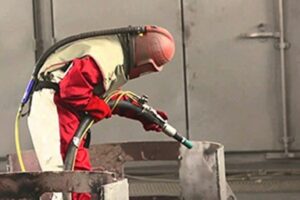
Glass blasting is used with both small and large items and works by blasting the surface with thousands of glass particles using compressed air.
This method is completely free of chemicals and results in a consistent matt finish. However, the item will not be corrosion resistant for some time – until the passive layer is restored.
There is also a risk of cross-contamination through iron particles which can lead to serious corrosion problems.
Electrochemical weld cleaning
Pros:
- Effective and fast
- No dangerous acids
Cons:
- Only the weld seam is treated
Electrochemical weld cleaning and passivation is a highly effective way of removing oxides from stainless steel welds.
The method combines phosphorus-based acids and electricity in a process that results in instantaneous cleaning and passivation.
Phosphoric acids are non-toxic and can be found in fizzy drinks and common household cleaning items – and is not even remotely as harmful as the pickling paste.
There is no need to clean the surface with water which makes your process much simpler – you will avoid all the hassle with wastewater disposal. The surface is merely treated with a neutralizing fluid and dried off using an industrial paper.
Electrochemical pickling is an environmentally friendly choice – causes no harm to your body or the environment under normal circumstances.
Due to this fact, but also portable and lightweight equipment, electrochemical weld cleaning can be done practically anywhere. We, of course, recommend using basic safety precautions (extraction systems, fresh air equipment) if you are working indoors for longer periods of time.
READ ABOUT BENEFITS OF ELECTROCHEMICAL WELD CLEANING HERE
Conclusion
When you are figuring out which pickling method to choose for your stainless steel, you should first and foremost decide whether to pickle the whole surface of the item or just the weld seam.
At Cougartron we provide you with all the equipment you need for electrochemical weld cleaning, and we have multiple machines that will get the job done.
Fill out our contact-form below, and we will be happy to guide you in choosing the right weld cleaning machine.
Get in touch
Loading...
Please wait while the form loads.


 English
English  English (US)
English (US)  German
German  Danish
Danish  Swedish
Swedish  French
French  Polish
Polish  Spanish
Spanish 